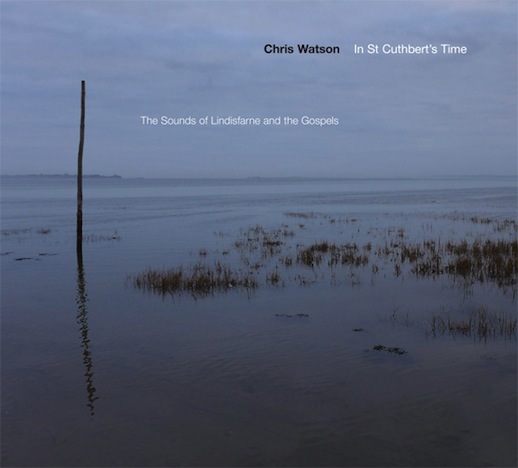To celebrate the exhibition of the Lindisfarne Gospels on Palace Green, Durham from July to September 2013, award–winning wildlife sound recordist Chris Watson has researched the sonic environment of the Holy Island as it might have been experienced by St Cuthbert in 700 A.D.
A Touch CD (TO:89). Reviewed by Cheryl Tipp.
Picture the scene. 7th Century Britain. A windswept and sea-battered island sitting two miles off the coast of Northumberland. Inhabited by a group of monks who had dedicated their lives to the word of God. Within the holy walls of the priory a bent figure patiently creates one of the greatest religious treasures in the history of British Christianity – the Lindisfarne Gospels.
Eadfrith, Bishop of Lindisfarne from 698-722 was the monk responsible for this remarkable illuminated manuscript. A note added to the end of the Gospels states that this was written for “God and St Cuthbert”, a former bishop of Lindisfarne. Both men seem to have been incredibly influenced by the natural sounds that surrounded them. While in self-imposed exile on the nearby Farne Islands, St Cuthbert introduced laws of protection for the local seabirds there, particularly the Eider Duck (affectionately known as Cuddy’s Ducks in Northumberland). Eadfrith too drew inspiration from natural history, incorporating stylised images of the birds he observed on Lindisfarne into the pages of the Gospels. I think it’s safe to say that both men would have drawn some additional spiritual sustenance from their wild landscapes – they were monks after all so spirituality wouldn’t have been in short supply. But many people, even to this day, have found great inspiration in the sights and sounds of the natural world; while labouring over the Gospels, Eadfrith would surely have experienced the same.
Equally inspired by the sounds of Lindisfarne and the story of this significant period of sacred creativity, wildlife sound recordist extraordinaire Chris Watson set about recreating the soundscapes that would have tickled the ears of those living and working on Lindisfarne during the 7th Century.
Modern day listeners are treated to four composed soundscapes that incorporate the songs and calls of animals that have existed on the island for millennia. Water and wind are also constant elements, reminding us of the wild topography of this ancient land. Each track is based on a season and so we move through the sounds of winter (winter), spring (lencten), summer (sumor) and autumn (haerfest). A plethora of species are encountered over the course of the year. Winter brings us the sounds of Wigeon, Oystercatchers, Brent Geese, Whooper Swans, the wingbeats of Greylag Geese passing overhead and a bubbling Curlew. With spring we hear Redshank, Black-headed Gulls, a drumming Snipe, the shimmering song of a Skylark in full flight and of course the gentle cooing of Cuddy’s Ducks (Listen closely – don’t you think they sound a little like Frankie Howard?). The sounds of summer are equally strident, with the cackling cries of Arctic Terns defending their nest sites, a Buzzard circling overhead and a group of calling Herring Gulls. Moving away from the shore we hear the songs of Swallows, Yellowhammers, House Martins and a Cuckoo being swept across the island by the unrelenting wind. The mooing of gentle cattle signifies both a source of nourishment for the monastic community and vellum for Eadfrith’s legacy. And finally to autumn where wading birds dominate the scene. The roars of Red Deer stags drift over the land and, as the tide turns, these are replaced with the haunting cries of Grey Seals. The sound of a monk’s bell draws to a close each soundscape; a thoughtful touch that subtly reinforces the connection between the island’s wildlife and religious inhabitants.
As you’d expect, the skill and attention to detail in putting these pieces together is of the highest calibre. If Eadfrith or St Cuthbert were able to hear ‘In St Cuthbert’s Time’ would they recognise the familiar soundscapes of the land that meant so much to them? You bet they would. Chris has created a work that is enjoyable to listen to, highly evocative and steeped in history. You’ll love what you hear and learn a thing or two as well. What more could you ask for?
Cheryl Tipp is the curator of wildlife sound recordings at the British Library and editor of issue #6 of An Antidote to Indifference.
